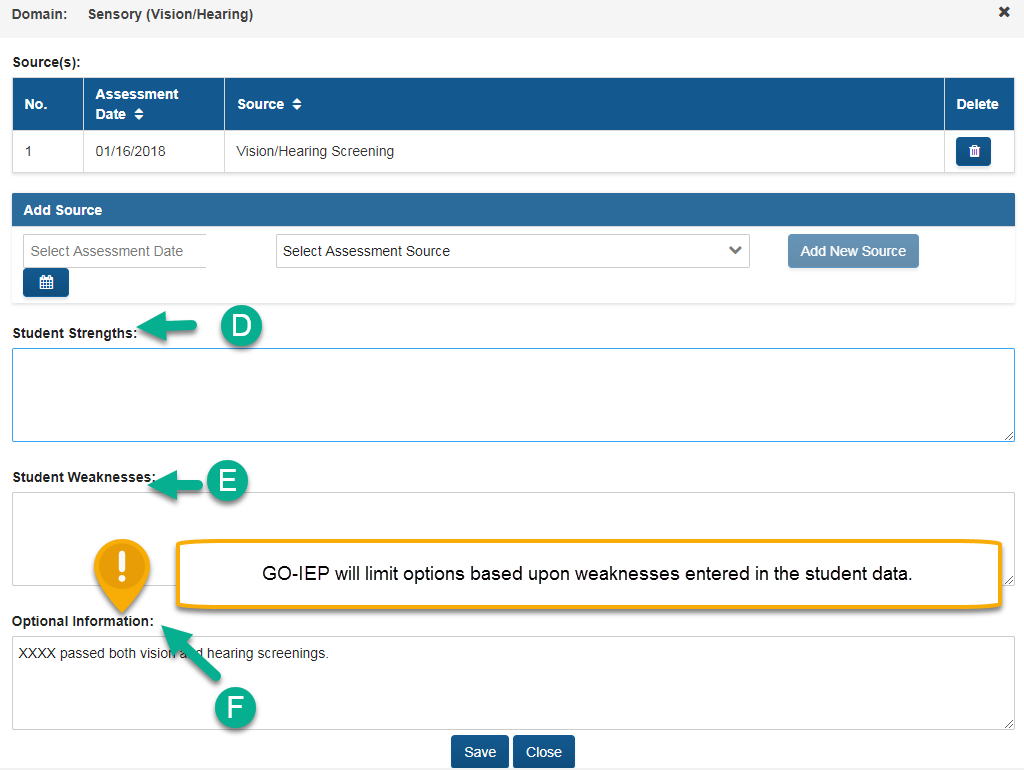4. Student Data
As this section is generally completed in draft form prior to the eligibility meeting, committee members may use input provided here to make decisions regarding any additional information/assessments which are needed prior to eligibility team meeting.
This section is a collection of all assessments (formal/informal), observations, interviews, reports, and work samples completed by a multidisciplinary team. All assessments and associated scores must be entered in this section. This may include both quantitative and qualitative data. It is organized into domains to prompt the team to consider the whole student. The team is responsible for conducting a comprehensive evaluation which must include an assessment of the student in all areas either formally or informally. It is imperative that all areas suspected as delayed have formal data to review. This section must be written in such a way that anyone can interpret the information included.

- Domain: Identify the domain. EVERY DOMAIN MUST BE COMPLETED. Please refer to the chart below for domains and examples.
|
Domain |
Examples |
|
Medical |
Formal results include a medical evaluation report from a licensed Doctor of Medicine or licensed clinical psychologist. Evaluation should include diagnosis/prognosis of the student’s health impairment indicating the medical condition causes limitations to strength, vitality or alertness which impact educational performance. This is a requirement for OHI eligibility. Informal information can also be obtained from parent and teacher interviews or records review. |
|
Sensory (Hearing/Vision) |
Sensory abilities related to sight or hearing. Use information from V/H screenings and/or any medical reports. |
|
Motor |
Gross motor to include attainment of skills such as crawling, walking, running and navigating environment physically. Fine motor is related to drawing, writing, grasping, eating and dressing. Informal information may be obtained from parent and teacher interviews or observations. Formal information may be obtained from OT or PT reports. |
|
Psychological Processing |
Attending, discrimination/perception, organization, short-term memory, long-term memory, conceptualization/reasoning, executive functioning, processing speed, and phonological deficits |
|
Intellectual Functioning |
IQ; General mental capacity such as learning, reasoning, problem solving |
|
Academic Achievement |
Oral Expression, Listening Comprehension, Written Expression, Basic Reading Skills, Reading Comprehension, Reading Fluency Skills, Mathematics calculation, Mathematical problem solving. Informal information may be obtained from teacher interviews or work samples. Report Card grades, state and locally required formal assessments may also be cited. |
|
Communication/Language |
Speech sounds, language, fluency, voice, oral motor competency, pragmatics. Informal information may be obtained from teacher interviews or observations. |
|
Observation |
Conducted in the learning environment, including the regular classroom setting, to document the student’s academic performance and behavior in the areas of difficulty. The observation must include information from the routine classroom instruction and monitoring of the student’s performance. This is required to be an area of weakness to support SLD or ID eligibility. |
|
Work Samples |
Analyzed classroom work samples indicating level performance as compared to the classroom normative sample. This is required to be an area of weakness to support LD eligibility. |
|
Adaptive Behavior |
Conceptual, Social, Practical skills required for daily living. A formal evaluation from the home and school setting indicating performance below a SS of 69 in both settings is required to support ID eligibility. Informal information may be obtained from teacher interviews or observations. |
|
Parent Input |
Information on student's strengths, weaknesses and interests as well as social interactions at home and in the community provided by the parent/guardian. |
|
Social/Emotional/Behavioral |
Understanding and controlling feelings & behaviors - Informal information may be obtained from parent and teacher interviews or observations. |
- Source: Every domain will require an assessment name or source of information from the list. “Other” can be selected if needed. If a commercially available assessment is often used and it is not on the list, please submit a support ticket with that request.
- Assessment Date: Each source will require a date the assessments (formal/informal), observations, interviews, reports, work samples, etc. were administered or obtained

Multiple sources and dates can be entered for each domain, as well as information about the results of each assessment. Select the edit button and a text box will appear for you to enter additional information the domain. Test scores as well as descriptions of the performance are required.
For each domain there are three text fields which can be used to describe how the student functions: student strengths, student weaknesses and optional information. Information can be entered in all 3 boxes as needed. At least 1 of the text boxes must have data. If no information is appropriate, leave the text box empty. Do not enter N/A or any similar comment.
- Student Strengths-Analyze and interpret all assessment results and enter that information in the appropriate text box. If the student exhibits no concerns in a specific domain then the team needs to document in the "strength" or the "other information" text box the evidence available. When appropriate, the statements should support the decision that no formal assessment is needed for the domain. Sample strength statements are listed in the next section.
- Student Weakness-A more in-depth formal assessment must be completed in all areas in which weaknesses are noted and in any other area deemed relevant. This is not a personal weakness but rather a weakness when compared to same age or grade peers. Generally, observations and interviews are not sufficient sources of information for domains with weaknesses when final eligibility decisions are being made.
- Optional Information- Sometimes data reflects a very “average” performance and the committee might be uncertain whether to include it as a strength or a weakness. In those cases, information can be entered in the optional box. Some users prefer to enter all test scores in this box and then produce a narrative description of the strength and weakness in the appropriate boxes above.